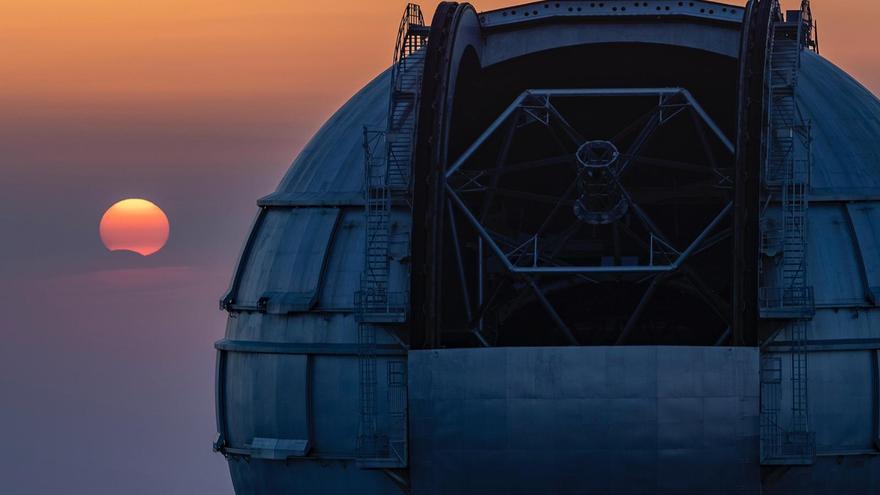
The Moon will take a bite out of the Sun for ten minutes this Monday. The satellite’s orbit will meet that of the Sun to cover at least a 3% of its surface. That is what the people in the Canary Islands will be able to see between 20:17 and 20:27 on Monday as they gaze at the sky during sunset.
This partial eclipse –which in different places in Mexico, the United States and Canada will be total– can be observed when the Sun is very close to the horizon, coinciding with the moment when the star begins to hide to give way to the night.
The small bite will only be visible from the islands in the province of Santa Cruz de Tenerife and, to observe it, it is essential that at least the horizon is clear. It will be much better observed at higher altitudes, although, again, everything will depend on what the clouds allow to be seen.
Gloomy Forecast
For now, the forecasts are not very promising, as the State Meteorological Agency (Aemet) has already warned that, during this Monday, there will be a predominance of cloudy skies in the north of the most mountainous islands. The Agency does not rule out the possibility that some weak and occasional rains could occur during the second half of the day.
However, there is a slight chance that it can be observed from the slopes facing south, as Aemet estimates that in these areas wide clearings are expected.
This event occurs when the Moon aligns perfectly to come between the Sun and the Earth, blocking the solar disk and causing darkness similar to nighttime.
Partial eclipses occur every year and a half in the Islands, the last one happened on October 14, 2023
[–>
Total solar eclipses occur approximately every year and a half, but they only impact a narrow strip on the surface of our planet.
Once we move away from that band, even if it is very close by, we can only observe it partially, making the event unremarkable or even possibly going unnoticed. Only in the totality band does the phenomenon become awe-inspiring and usually generates pristine enthusiasm among those fortunate enough to witness it.
These solar eclipses only occasionally occur because the Moon does not orbit on the exact same plane as the Sun and the Earth. The moment they align is known as eclipse season, which happens twice a year.
If weather conditions allow it, residents in the path of a total solar eclipse can view the Sun’s corona, or its outer atmosphere, which is otherwise usually obscured by the Sun’s bright face.
A total solar eclipse is the only type of solar eclipse where viewers can briefly remove their specially designed eclipse-viewing glasses (which differ in characteristics from regular sunglasses) during the brief period when the Moon completely blocks the Sun.
In this sense, it is important to remember that solar observation should always involve safety measures such as using adapted glasses to prevent burning our retinas. It is important to avoid using optical systems such as binoculars or telescopes without the corresponding solar filters.
The north of Lanzarote will be able to see an almost total eclipse in 2078; the rest will have to wait until 2243
[–>
Canary Islands have not witnessed a total solar eclipse since 65 years ago (1959) and will not witness one again for over 200 years: in the year 2243. That year, many scientists gathered in Tenerife to witness the event, and most were amazed by the clarity with which the skies of the Canary Islands allowed them to see the cosmos.
But not all news is bad. The north of Lanzarote will be able to witness an almost total solar eclipse in 2078 during sunset, and the Iberian Peninsula has two important dates between 2026 and 2027. The Iberian Peninsula will be able to enjoy total solar eclipses on August 12, 2026 and August 2, 2027, as well as an annular solar eclipse on January 26, 2028. The latter occurs when the Moon is at the farthest point in its orbit, preventing it from completely covering the Sun.
In the Canary Islands, it is more common to see the Moon darkening a small part of the Sun. In the last decade, the Archipelago has experienced ten eclipses of this kind, the last two on October 14, 2023, and June 10, 2021.
















